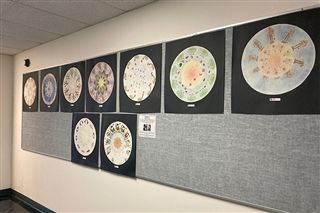It doesn’t come as a surprise that when asked what they do in their spare time, students respond Netflix without hesitation. Movies, with real actors or animations, are a staple in the lives of teenagers today, as a pastime or a form of de-stressing. Recently, the Grade 10s explored the science behind animation, and how still images move in quick succession to create the illusion of motion.
A phenakistoscope is one of the earliest forms of animation. A series of illustrations line a flat circular canvas attached to a spinning handle. The user peers through slits in the disc and sees the animation reflected in a mirror as the images spin.
Grade 10 art classes spent around 25 hours of the term designing and planning their animations. The first step of the animation process was to learn about the phenakistoscope and the basics of making an animation. The process of animation is not easy, and as the Grade 10s learned, there were many details that needed to be taken into account, including creating frames and illustrations that, when spun, create an illusion of movement. In addition, the number of frames and illustrations that were included had to be taken into consideration, as there was a limited amount of space and each artist needed to include just enough frames so the eye could detect the spinning images and movement.
After researching, students used their imagination to plan and design their animations. At the beginning, students had three different ideas that they then had to narrow down to a final choice. Students had to consider a cyclical story line for their animations—a story that would cycle and repeat smoothly: such as a rose wilting and blooming again or a gymnast performing consecutive flips. This way, there is no real “end” or “beginning”, allowing the animation to start from any frame.
After their illustrations were complete, students applied colour to their sketches using coloured pencils. Using a pencil sharpener, students shaved off the tip of their pencils and rubbed the shavings in circles. This technique creates a cloudy and smooth texture to the piece that would enhance the animation and creat a seamless background to each frame
The final step was to create the animation. Using different stop-motion apps, students took pictures of their illustrations and compiled the separate photos to create a stop-motion GIF. It’s one thing to look and appreciate the detail that went into designing the still images, but they look so much better as an animation. Visit GNS IB Visual Arts- Phenakistoscopes to view some of the amazing animations that were created!





